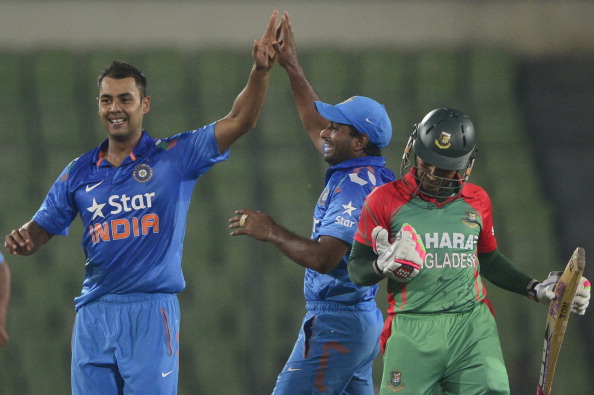
SK Elite: Stuart Binny notches up the best ODI figures by an Indian bowler

Stuart Binny, a player who has received plenty of criticism in his short span of career for underperforming in most of the opportunities that he got in the Indian team, a fair amount to be precise. People believed he was a misfit in the line-up and questioned his selection on a number of occasions.
But the same bloke holds the record for the best bowling figures by an Indian in One Day Internationals. In a country that has produced bowling stalwarts like Anil Kumble, Zaheer Khan and Javagal Srinath, the record going to Binny’s credit may sound a little weird.
But believe it not, he is up there with his figures of 4/6 shining at the top. You heard it right. 6 wickets for just 4 runs and it’s Binny who accounted for those figures.
It happened on June 17, 2014, when India visited Bangladesh for a 3-ODI series. Let’s revisit the iconic match in India’s cricketing history.
A grim setup
The India-Bangladesh rivalry might have intensified in the past couple of years but it wasn’t the same in 2014. By that time, the Rohit Sharma and the no-ball controversy of the World Cup quarterfinal hadn’t happened, Bangladesh hadn’t defeated India 2-1 at home, the Asia Cup final hadn’t happened, the final over thriller of the World T20 hadn’t transpired either.
So Bangladesh were just the minnows of the game by then and India didn’t take them as seriously as they do now. As a result, the big stars like MS Dhoni, Virat Kohli, Rohit Sharma, Ravichandran Ashwin were rested and a second string squad led by Suresh Raina was sent to the neighbouring country assuming the opposition wouldn’t pose too much of a threat.
The first ODI took place in Dhaka where India edged past the hosts quite comfortably. The lack of interest from the viewers was evident. The enthusiastic Bangladeshi fans were not great in number to witness the game and the Indian contingent was nowhere to be seen either.
English like conditions in Dhaka
Normally, we would associate Dhaka to present a low and slow wicket that would assist their spinners just like what was on show in the first ODI. Come the second match, the players were treated to conditions that were unheard of in the subcontinent.
There was enough juice on the surface for the fast bowlers to be interested. The rain also had its impact as it delayed the match for about two and a half hours and as a result, the game was curtailed to 41-over a side.
Extra cover: 5 mind-boggling recalls to the Indian cricket team
The home side won the toss and opted to bowl first to give the chance to their seamers to exploit the conditions first up. The ball was darting around and it felt as if cricket was being played at the Lord’s and not Dhaka.
Bangladeshi pacers dominated the Indian batsmen and bundled them out for just 105 in 25.3 overs. The whole innings lasted for only 140 minutes with Suresh Raina being the top scorer with 27 runs. The debutant Taskin Ahmed was the major destructor as he bagged a five-for.
The Binny-storm

Just 106 to get, Bangladesh were the favourites at the halfway stage. That’s what we thought and indeed the very few people who turned up to watch the game. It would have been a walk in the park on most days but as it’s said, in the game of cricket, don’t judge a pitch until both sides have played on it. The saying proved to be apt for the occasion.
Tamim Iqbal struck a boundary off the very first ball and it seemed as if the night belonged to the Bangladeshis. But off the very next ball, he nicked one to the keeper off Mohit Sharma’s bowling which sent a message to the batting camp that the game was not over just yet.
Anamul Haque too departed soon for a duck and became the second victim of Sharma. Mohammad Mithun and the then skipper Mushfiqur Rahim stitched together a partnership of 31 runs and took the side to 44/2 in the 12th over. The duo started settling at the crease as the game drifted slightly in favour of the hosts.
Then arrived Stuart Binny with his gentle medium pace. In his second over, Rahim edged one to the keeper down the leg side and it opened the floodgates.
Binny, whose bowling would prove to be the least effective on most decks in the world, suddenly became the unplayable bowler. The conditions were tailor-made for his style of bowling.
To his credit, he did what was required on the occasion. The right-hander pitched the ball up and targetted the right areas and allowed the pitch do the rest. There was enough movement both in the air and off the surface that it proved to be impossible for the batsmen to tackle the Indian seamer.
He went on to account for the wickets of Mithun, Mahmudullah, Mashrafe Mortaza, Nasir Hossain and Al-Amin Hossain to end up with figures of 4/6 from 4.4 overs with 2 maidens and surpassed Anil Kumble’s figures of 12/6 to reach the pole position in terms of the best bowling figures by an Indian in the ODI format.
The hosts were literally blown away by Binny who was ably supported by Mohit who ended up with 4 wickets himself. From 44/2, Bangladesh were bowled out for 58 in the 18th over. The last 8 wickets lasted for just 37 balls and added only 14 runs. India won the match by 47 runs and with that, the series as well.
Binny may not be around in the international circuit anymore and his road to the comeback in the Indian team could be nearly closed, but with that majestic spell, he certainly embedded himself in the history of Indian cricket forever.